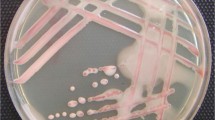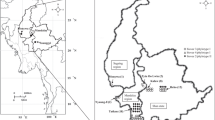Abstract
We assessed the geographic distribution, biovar, phylotype, DNA fingerprints (rep-PCR), and/or endoglucanase sequence of potato bacterial wilt pathogen, Ralstonia solanacearum (Rs), in Japan. Rs has been isolated from potato fields in southwestern, warm, temperate regions. Of the 188 isolates, 74 belonged to biovar N2 (39%), 44 to biovar 3 (24%), and 70 to biovar 4 (37%). Biovars N2 and 4 strains were widely distributed, from northern (Hokkaido) to southern (Okinawa) Japan. Based on the results of multiplex-PCR analysis, every potato strains belonged to either phylotype I or IV. Phylotype I comprised both biovars 3 and 4 strains. On the other hand, phylotype IV included biovar N2 strains. None of the strains belonged to phylotype II or III or biovar 1 or 2. Phylogenetic analysis based on DNA fingerprints and endoglucanase gene sequences clarified the genetic diversity of the Japanese potato strains and the close genetic relationship between the Japanese strains and the Asian strains in phylotypes I and IV.



Similar content being viewed by others
References
Arwiyanto T, Goto M, Takikawa Y (1993) Characterization of bacteriocins produced by Pseudomonas solanacearum. Ann Phytopathol Soc Jpn 59:114–122
Castillo JA, Greenberg JT (2007) Evolutionary dynamics of Ralstonia solanacearum. Appl Environ Microbiol 73:1225–1238
Denny TP, Hayward AC (2001) II. Gram-negative bacteria Ralstonia. In: Schaad NW, Jones JB, Chun W (eds) Laboratory guide for identification of plant pathogenic bacteria. APS Press, St. Paul, pp 151–174
Dice LR (1945) Measures of the amount of ecologic association between species. Ecology 26:297–302
Elphinstone JG (2005) The current bacterial wilt situation: a global overview. In: Allen C, Prior P, Hayward AC (eds) Bacterial wilt disease and the Ralstonia solanacearum species complex. APS Press, St. Paul, pp 9–28
Fegan M, Prior P (2005) How complex is the “Ralstonia solanacearum species complex”? In: Allen C, Prior P, Hayward AC (eds) Bacterial wilt disease and the Ralstonia solanacearum species complex. APS Press, St. Paul, pp 449–461
Hayward AC (1964) Characteristics of Pseudomonas solanacearum. J Appl Bacteriol 27:265–277
Hayward AC (1991) Biology and epidemiology of bacterial wilt caused by Pseudomonas solanacearum. Annu Rev Phytopathol 29:65–87
Hayward AC (1994) Systematics and phylogeny of Pseudomonas solanacearum and related bacteria. In: Hayward AC, Hartman GL (eds) Bacterial wilt: the disease and its causative agent, Pseudomonas solanacearum. CAB International, Wallingford, pp 123–135
Hayward AC, El-Nashaar HM, Nydegger U, De Lindo L (1990) Variation in nitrate metabolism in biovars of Pseudomonas solanacearum. J Appl Bacteriol 69:269–280
Hayward AC, Elphinstone JG, Caffier D, Janse JD, Stefani E, French ER, Wright AJ (1998) Round table on bacterial wilt (brown rot) of potato. In: Prior PH, Allen C, Elphinstone JG (eds) Bacterial wilt disease: molecular and ecological aspects. Springer, Heidelberg, pp 420–430
Hendrick CA, Sequeira L (1984) Lipopolysaccharide-defective mutants of the wilt pathogen Pseudomonas solanacearum. Appl Environ Microbiol 48:94–101
Horita M, Tsuchiya K (2001) Genetic diversity of Japanese strains of Ralstonia solanacearum. Phytopathology 91:399–407
Horita M, Ooshiro A, Tsuchiya K (2005) Characteristics of Ralstonia solanacearum biovar N2 strains in Asia. J Phytopathol 153:209–213
Horita M, Tanaka F, Fuwa H (2009) Characteristics of seed-borne bacterial diseases of potato and development of simple detection methods of the pathogens (in Japanese). Plant Protect 63:98–103
Janse JD, van den Beld HE, Elphinstone J, Simpkins S, Tjou-Tam-Sin NAA, van Vaerenbergh J (2004) Introduction to Europe of Ralstonia solanacearum biovar 2, race 3 in Pelargonium zonale cuttings. J Plant Pathol 86:147–155
Jaunet TX, Wang JF (1999) Variation in genotype and aggressiveness diversity of Ralstonia solanacearum race 1 isolated from tomato in Taiwan. Phytopathology 89:320–327
Jeong Y, Kim J, Kang Y, Lee S, Hwang I (2007) Genetic diversity and distribution of Korean isolates of Ralstonia solanacearum. Plant Dis 91:1277–1287
Katayama K, Kimura S (1986) Ecology and protection of bacterial wilt of potato: I. Ecology and strains of Pseudomonas solanacearum (in Japanese with English summary). Bull Nagasaki Pref Agric Exp Stn 14:1–30
Kelman A (1954) The relationship of pathogenicity of Pseudomonas solanacearum to colony appearance on a tetrazolium medium. Phytopathology 44:693–695
Kimura M (1980) A simple method for estimating evolutionary rates of base substitutions through comparative studies of nucleotide sequences. J Mol Evol 16:111–120
Lewis Ivey ML, McSpadden Gardener BB, Opina N, Miller SA (2007) Diversity of Ralstonia solanacearum infecting eggplant in the Philippines. Phytopathology 97:1467–1475
Liu Y, Kanda Y, Yano K, Kiba A, Hikichi Y, Aino M, Kawaguchi A, Mizoguchi S, Nakaho K, Shiomi H, Takikawa Y, Ohnishi K (2009) Molecular typing of Japanese strains of Ralstonia solanacearum in relation to the ability to induce a hypersensitive reaction in tobacco. J Gen Plant Pathol 75:369–380
Louws FJ, Fulbright DW, Stephens CT, de Brujin FJ (1994) Specific genomic fingerprints of phytopathogenic Xanthomonas and Pseudomonas pathovars and strains generated with repetitive sequences and PCR. Appl Environ Microbiol 60:2286–2295
Mahbou Somo Toukam G, Cellier G, Wicker E, Guilhaud C, Kahane R, Allen C, Prior P (2009) Broad diversity of Ralstonia solanacearum strains in Cameroon. Plant Dis 93:1123–1130
Narita T (1958) Studies on the bacterial diseases of potato in Hokkaido (in Japanese with English summary). Rep Hokkaido Pref Agric Exp Stn 8:1–74
Norman DJ, Zapata M, Gabriel DW, Duan YP, Yuen JMF, Mangravita-Novo A, Donahoo RS (2009) Genetic diversity and host range variation of Ralstonia solanacearum strains entering North America. Phytopathology 99:1070–1077
Nouri S, Bahar M, Fegan M (2009) Diversity of Ralstonia solanacearum causing potato bacterial wilt in Iran and the first record of phylotype II/biovar 2T strains outside South America. Plant Pathol 58:243–249
Ooshiro A (2008) Control of bacterial wilt by Geranium carolinianum L (in Japanese). Plant Protect 62:90–95
Ozaki K, Kimura T (1992) Studies on biovar of Pseudomonas solanacearum from solanaceous plants and its several characteristics (in Japanese with English summary). Bull Chugoku Natl Agric Exp Stn 10:41–48
Poussier S, Prior P, Luisetti J, Hayward C, Fegan M (2000a) Partial sequencing of the hrpB and endoglucanase genes confirms and expands the known diversity within the Ralstonia solanacearum species complex. Syst Appl Microbiol 23:479–486
Poussier S, Trigalet-Demery D, Vandewalle P, Goffinet B, Luisetti J, Trigalet A (2000b) Genetic diversity of Ralstonia solanacearum as assessed by PCR-RFLP of the hrp gene region, AFLP and 16S rRNA sequence analysis, and identification of an African subdivision. Microbiology 146:1679–1692
Prior P, Fegan M (2005) Recent developments in the phylogeny and classification of Ralstonia solanacearum. Acta Hortic 695:127–136
Swanson JK, Yao J, Tans-Kersten J, Allen C (2005) Behavior of Ralstonia solanacearum race 3 biovar 2 during latent and active infection of geranium. Phytopathology 95:136–143
Taghavi M, Hayward C, Sly LI, Fegan M (1996) Analysis of the phylogenetic relationships of strains of Burkholderia solanacearum, Pseudomonas syzygii, and the blood disease bacterium of banana based on 16S rRNA sequences. Int J Syst Bacteriol 46:10–15
Thompson JD, Higgins DG, Gibson TJ (1994) CLUSTAL W: improving the sensitivity of progressive multiple sequence alignment through sequence weighting, position-specific gap penalties and weight matrix choice. Nucleic Acids Res 22:4673–4680
Thwaites R, Mansfield J, Eden-Green S, Seal S (1999) RAPD and rep PCR-based fingerprinting of vascular bacterial pathogens of Musa spp. Plant Pathol 48:121–128
Villa JE, Tsuchiya K, Horita M, Natural M, Opina N, Hyakumachi M (2005) Phylogenetic relationships of Ralstonia solanacearum species complex strains from Asia and other continents based on 16S rDNA, endoglucanase, and hrpB gene sequences. J Gen Plant Pathol 71:39–46
Wakimoto S, Utatsu I, Matsuo N, Hayashi N (1989) Multiplication of Pseudomonas solanacearum in pure water. Ann Phytopathol Soc Jpn 48:620–627
Williamson L, Nakaho K, Hudelson B, Allen C (2002) Ralstonia solanacearum race 3, biovar 2 strains isolated from geranium are pathogenic on potato. Plant Dis 86:987–991
Yabuuchi E, Kosako Y, Yano I, Hotta H, Nishiuchi Y (1995) Transfer of two Burkholderia and an Alcaligenes species to Ralstonia gen. nov.: proposal of Ralstonia pickettii (Ralston, Palleroni and Doudoroff, 1973) comb. nov., Ralstonia solanacearum (Smith 1896) comb. nov. and Ralstonia eutropha (Davis 1969) comb. nov. Microbiol Immunol 39:897–904
Yap IV, Nelson RJ (1996) Winboot: a program for performing bootstrap analysis of binary data to determine the confidence limits of UPGMA-based dendrograms. IRRI Discussion Paper Series 14. International Rice Research Institute, Manila, Philippines
Acknowledgments
Authors thank all of those who contributed the strains or supported our field survey in this study.
Author information
Authors and Affiliations
Corresponding author
Additional information
Sequences of partial endoglucanase gene fragments have been deposited in DDBJ/EMBL/Genbank databases under the accession numbers AB523862-AB523878.
Rights and permissions
About this article
Cite this article
Horita, M., Suga, Y., Ooshiro, A. et al. Analysis of genetic and biological characters of Japanese potato strains of Ralstonia solanacearum . J Gen Plant Pathol 76, 196–207 (2010). https://doi.org/10.1007/s10327-010-0229-2
Received:
Accepted:
Published:
Issue Date:
DOI: https://doi.org/10.1007/s10327-010-0229-2




